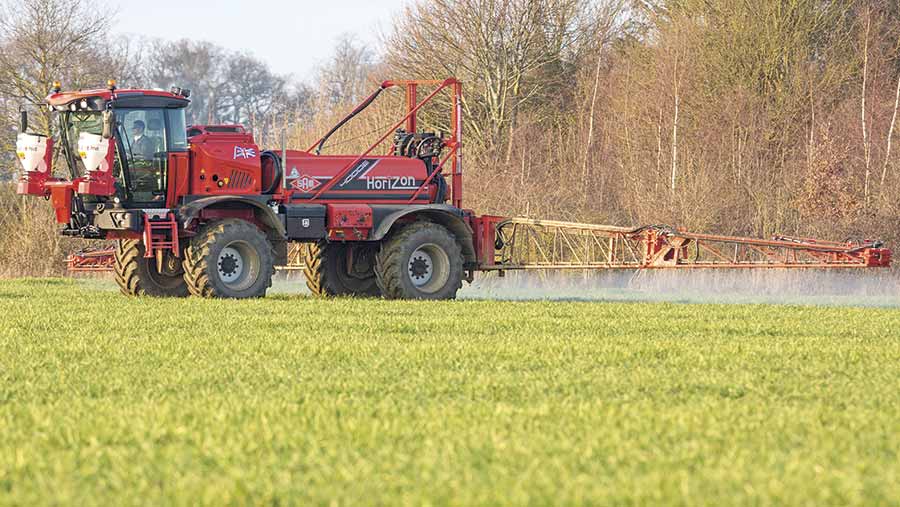Crop Watch: Cooling soils turn thoughts to late residuals
 © Tim Scrivener
© Tim Scrivener The turn of the month has finally seen temperatures start to fall but eastern growers should exercise patience until soil moisture levels increase and soil temperatures fall further, says Ben Pledger.
Wetter weather further north has hampered drilling to a greater extent, notes David Martindale, who now believes planting will only be possible on the most free-draining land.
There has been a mixed reaction to the performance of residual herbicides, chiefly based on the state of seed-beds, but growers should not fear crop bleaching, says Tod Hunnisett, as it won’t impact yield.
For crops which have missed a pre-emergence spray, Neil Potts says western growers should be rectifying this as soon as possible with a contact herbicide as options after crop emergence are limited.
See also: Video: The plan that battered blackgrass in 12 months
East: Ben Pledger
Farmacy (Bedfordshire/Hertfordshire)
 Now we’re entering November, this season’s sugar beet campaign is well under way. Yields generally seem to be good across the board, which has pleased growers, with yields of up to 100t/ha reported in some places.
Now we’re entering November, this season’s sugar beet campaign is well under way. Yields generally seem to be good across the board, which has pleased growers, with yields of up to 100t/ha reported in some places.
The dry spell over the past few weeks has also allowed good seed-beds to be prepared for following crops of winter wheat.
The drier weather is however posing a problem with residual herbicides, especially on heavier, cloddier seed-beds.
Healthy blackgrass plants are emerging from between clods, and have probably not come into contact with any chemistry on their way out of the ground.
Lack of moisture is preventing the uptake of pre-emergence actives such as flufenacet with fewer sites than usual showing good control.
This is especially true in land that was worked in the wet in September, and subsequently baked out on top prior to drilling.
Expectations of the control from residual herbicides this autumn will need to be managed, and follow-up treatments with contact materials may be required.
Likewise, earlier drilled winter beans are now only days away from emergence and applications of pre-emergence residual herbicides have been delayed as late as product labels allow in order for soil moisture to increase and temperatures to decrease.
In these cases, glyphosate has been added to take care of any already-emerged weeds.
Aphid migration
Warmer weather at the end of October provided good conditions for aphids to migrate into crops.
In cereals, winged grain aphids and bird cherry oat aphids could easily be found, with colonies of wingless aphids already present on isolated plants.
Earlier drilled crops treated with clothianidin will now be running out of protection, and along with wheat and barley that hasn’t been treated, they should now be inspected.
If aphids are present, an insecticide should be applied to prevent the spread of barley yellow dwarf virus.
Active ingredients such as cypermethrin or lambda-cyhalothrin can be used, however please pay attention to individual product labels, as buffer zone requirements vary greatly between the different options.
Please also note we need to check the success of treatments since there is the potential for resistance to pyrethroids in grain aphids.
At the same time as seeing aphids migrating into cereals, peach potato aphid are migrating into oilseed rape crops, potentially infecting the crop with turnip yellows virus. Affected crops have now been treated with thiacloprid to reduce this threat.
North: David Martindale
Arable Alliance (Yorkshire)
 The autumn struggle continues with heavy rain at the weekend proving decisive on what land can still be drilled this side of Christmas.
The autumn struggle continues with heavy rain at the weekend proving decisive on what land can still be drilled this side of Christmas.
Now only free-draining soils stand a chance of being sown with wheat.
The weather has continued to limit spray opportunities with blackgrass the most likely winner from later herbicide applications in all crops.
Slugs continue to cause havoc. It is not just wheat crops following oilseed rape that have been affected but also second wheats and winter barley, especially on rough seed-beds.
Seed-bed quality has covered the whole spectrum this autumn, ranging from excellent through to mediocre and then to the “I’d-rather-not-look” state.
September-sown wheat crops are now tillering and it will not be long before the blackgrass is too.
Contact acting herbicides such as Atlantis (iodosulfuron + mesosulfuron) or Unite (flupyrsulfuron + pyroxulam) are being applied where they are still deemed to be effective as a final attack against blackgrass.
Later-sown wheat crops will not get advanced enough to be sprayed with these before spring so the combination of later sowing and a residual herbicide plan will be the blackgrass control strategy.
Bleaching no cause for concern
Winter barley crops have developed well so far with some bleaching from pre-emergence herbicide mixes evident.
The crop will grow away from these symptoms and with herbicide programmes complete for blackgrass and sterile brome control then good crop competition is all that can be done to limit the impact of these weeds.
On earlier-sown crops on lighter soils mildew levels are quite high but none so far have warranted a fungicide with keeping ahead of any signs of manganese deficiency the key on these forward lush crops.
Oilseed rape has grown rapidly in the past month after a very steady start during September and phoma is at threshold in all crops now with some fungicides already applied on more susceptible varieties.
Those fields which have not yet had a fungicide are due to receive one as soon as conditions allow and this is frequently being mixed with residual herbicides such as propyzamide for grassweed control.
Although soil temperatures may be slightly higher than ideal for optimal propyzamide persistence there are so few spray opportunities during November that some compromise to the timing is required.
South: Tod Hunnisett
AICC (Sussex)
 The rains have finally abated allowing combining to be completed (or abandoned) and, on all but the heaviest of land after maize, drilling is finished.
The rains have finally abated allowing combining to be completed (or abandoned) and, on all but the heaviest of land after maize, drilling is finished.
A supreme effort has been made to ensure pre-emergence herbicides have gone on as planned, and most seem to be working quite effectively.
There has been a bit of crop effect in some cases, but I never worry too much about autumn crop effect.
I’ve never known it affect yield and generally speaking if it yellows the crop it absolutely annihilates the weeds.
Oilseed rape ranges from 2cm in height to knee-high. Give me a knee-high crop any day over backward oilseed rape this time of year.
We’ve finally had a few frosts that will slow things down and soil temperatures are dropping to a point where applications of propyzamide and carbetamide will be appropriate.
Having said that, I’ve always been surprised in the past at how well they work when they have gone on early when soil temperatures are supposedly too high.
Phoma levels vary; the incidence seems to be more related to the crop’s proximity to last year’s rape crops than varietal susceptibility.
Crusoe under scrutiny
Brown rust can be found quite easily in earlier-sown crops of Crusoe.
I’m not doing anything about it now but it is simply reinforcing my policy of high input first spring fungicide applications. I can’t see this variety lasting much longer if it doesn’t yield over the top next year.
Slugs are continuing to be a nuisance in places, less so now that the night-time temperatures have dropped, but there is still a high population after oilseed rape.
Comparing wheat after winter oilseed rape and wheat after spring beans one wonders if there shouldn’t be value worked into the gross margin of these different break crops to account for the associated slug problems in the following wheat crops.
West: Neil Potts
Matford Arable (Devon)
 This year has seen possibly the worst weather for a harvest and planting period that I can remember – winter 2001/02 was bad but it had a better preceding harvest period.
This year has seen possibly the worst weather for a harvest and planting period that I can remember – winter 2001/02 was bad but it had a better preceding harvest period.
The oilseed rape crop has had major problems with slugs in places, despite repeated applications of slug pellets to the affected areas.
Those crops not affected by slugs are now arguably carrying too big a canopy for this stage of the season as the temperatures have been higher than average and this has driven rapid growth.
Most crops have either received or are about to receive a fungicide to control phoma and light leaf spot.
Several have also been treated for cereal volunteers which have been prevalent this year due to a late harvest of the previous crop and a rapid planting of the rape afterwards.
Lush crops
The few cereal crops that were planted in September are now looking very forward and too thick.
While the correct seed rates for the time of year were used the growing conditions have been too good.
Many of the early drilled crops are again carrying too much canopy, with all the implications this brings for disease and lodging later in the year.
Many growers have been too quick to increase seed rates as the season has moved on as soil temperatures have remained unseasonably high and emergence occurred very quickly for the time of year.
This effectively means that they have been drilled earlier and seed rates should have been held down in recognition of this.
Many crops destined for a pre-emergence herbicide treatment have missed. This now needs to be rectified swiftly, particularly in the winter barley and oat crops, where post-emergence grassweed control options are limited.
In the absence of blackgrass, we have a bigger window and more options to choose from in the wheat crop.
Maize has been the high spot this year with yields on even-exposed sites above their average, but obviously not matching some of the highs experienced on the more favourable sites for maize growing.
Yet again the earlier drilled crops have on the whole performed better than the later planted crops.
This really is a crop that needs to be planted at the first sensible opportunity rather than later, in order for it to make best use of our relatively short growing season for the crop.

